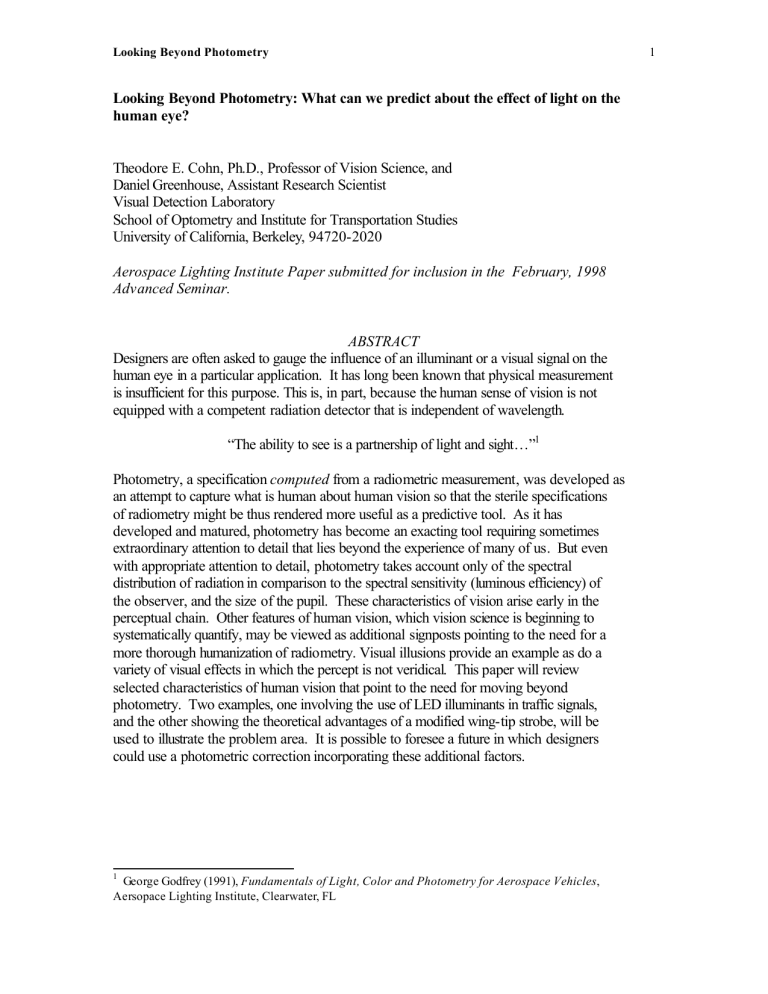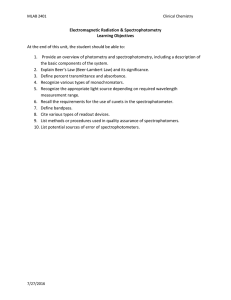Looking Beyond Photometry - University of California Transportation

Looking Beyond Photometry
Looking Beyond Photometry: What can we predict about the effect of light on the human eye?
Theodore E. Cohn, Ph.D., Professor of Vision Science, and
Daniel Greenhouse, Assistant Research Scientist
Visual Detection Laboratory
School of Optometry and Institute for Transportation Studies
University of California, Berkeley, 94720-2020
Aerospace Lighting Institute Paper submitted for inclusion in the February, 1998
Advanced Seminar.
ABSTRACT
Designers are often asked to gauge the influence of an illuminant or a visual signal on the human eye in a particular application. It has long been known that physical measurement is insufficient for this purpose. This is, in part, because the human sense of vision is not equipped with a competent radiation detector that is independent of wavelength.
“The ability to see is a partnership of light and sight…”
1
Photometry, a specification computed from a radiometric measurement, was developed as an attempt to capture what is human about human vision so that the sterile specifications of radiometry might be thus rendered more useful as a predictive tool. As it has developed and matured, photometry has become an exacting tool requiring sometimes extraordinary attention to detail that lies beyond the experience of many of us. But even with appropriate attention to detail, photometry takes account only of the spectral distribution of radiation in comparison to the spectral sensitivity (luminous efficiency) of the observer, and the size of the pupil. These characteristics of vision arise early in the perceptual chain. Other features of human vision, which vision science is beginning to systematically quantify, may be viewed as additional signposts pointing to the need for a more thorough humanization of radiometry. Visual illusions provide an example as do a variety of visual effects in which the percept is not veridical. This paper will review selected characteristics of human vision that point to the need for moving beyond photometry. Two examples, one involving the use of LED illuminants in traffic signals, and the other showing the theoretical advantages of a modified wing-tip strobe, will be used to illustrate the problem area. It is possible to foresee a future in which designers could use a photometric correction incorporating these additional factors.
1
1
George Godfrey (1991), Fundamentals of Light, Color and Photometry for Aerospace Vehicles ,
Aersopace Lighting Institute, Clearwater, FL
Looking Beyond Photometry
INTRODUCTION
The effects of light upon the eye are quantified by photometry. Thus when one asks to what degree one light source has a visual effect similar to that of another, one is invoking a photometric specification. The problem is that photometry is limited, and its limits are unfortunately implicit. In this paper we describe an approach to arriving at a reckoning of the equivalence of visual effects of two dissimilar sources, and show that to achieve this reckoning one must first understand the implicit strictures of photometry and then develop a process to advance beyond those strictures.
Consider this question: Under what conditions is an LED light source visually equivalent to an incandescent source? The question has arisen in the enterprise of evaluating the suitability of
LED-based illuminants as replacements for incandescent illuminants in traffic signals. The question as posed is neither suitable to the real world application of the answer, nor to the photometric world. In the case of the former one might ask if a red LED traffic signal would stop the same fraction of drivers as the incandescent signal that it replaces. In the case of the latter, one might ask whether the LED signal is photometrically equivalent to the incandescent signal. These are different questions, and examining the differences will reveal not only which implicit assumptions in photometry limit the inquiry, but also how to circumvent those limits.
The photometric answer: The photometric analysis of this question appears at first look to be trivial. One simply makes a luminance determination and asks if the LED luminance is at least as great as that of the incandescent.
Photometrists are used to worrying over questions of this sort and a predominant barrier to a simple answer is that the two sources are spectrally different.
However, spectral difference does not prevent a determination of brightness equivalence, and that determination, undertaken by straightforward procedures
2
(Walsh, 1953; Wyszecki and Stiles, 1967) is readily accomplished. In this case, brightness is taken as a proxy for visual effect of luminance, luminance is accepted as proxy for (suprathreshold) detection, and detection is taken as a proxy for the task of identification. And finally, identification is taken as a proxy of stopping at an intersection when signaled to do so.
The pragmatic answer: One might, in considering the number of assumptions involved choose instead to swap the fixtures in the real world and count the number of missed signals. Owing to the cost of real world mishaps, this approach isn't (or usually isn't) adopted.
The problems with the photometric approach: There are a number of factors present in the real world situation which render photometry several steps removed from supplying a complete answer.
Examining these is useful before displaying a unified way to treat them all. (In all of the following we shall assume that the population of eyes is homogeneous, an unjustified assumption
2
J. W. T. Walsh, Photometry , Constable,
London, 1953; G. Wyszecki and W. S. Stiles,
Color Science , 1967
2
Looking Beyond Photometry which requires its own consideration and which lies beyond the scope of this paper.) The first problem is that photometry depends upon the choice of adaptation level. Photopic (lightadapted) photometry differs from scotopic (dark-adapted) photometry in terms of the presumed spectral sensitivity of the visual system. The dependence is well understood, but the problem is that the answer in one case will not be the same as the answer in the next. To circumvent this problem, one might adopt the minimal error criterion of accepting the measurement least favorable to the new lamp.
The next problem is that photometry traditionally deals with spatially homogeneous, static targets. Real world targets often come close to this ideal, but when they don't, visual effectivity is altered. The spatial contrast sensitivity function only begins to capture the richness of the relationship between target spatial configuration and target effect. Even spatially homogeneous targets are affected by size (the reader will recall that much of the photometric literature relates solely to one-degree diameter visual targets), and this of course matters for traffic signals, the size
(or visual angle) of which is dependent on the distance at which it is viewed.
Size, however, is not the only spatial configuration issue. Certain zones in a target may contribute more to detection than others. Hammond et al
3
showed that in heterochromatic flicker photometry, the edge of the target is pivotal in the determination.
3
B. R. Hammond, B. R. Wooten, and D. M.
Snodderly (1997) “Individual variations in the spatial profile of human macular pigment”, J.
Opt. Soc. Am. Ser./ A 14, 1187-1196.
Target dynamics present another degree of variability and the variance due to this factor is correlated with that due to target geometry. Incandescent lamps turn on with a nearly perceptible gradual time course. LED’s turn on orders of magnitude more suddenly, and there is evidence that this sudden onset confers a detectability advantage which a photometer cannot register.
Also, dynamics and spatial configuration together can play a profound role. It has been demonstrated that the best seen visual stimulus is one that is moving
4
.
Moreover, a static target, briefly presented and then moved suddenly to a new adjacent location, gives the appearance of motion and exhibits significantly lower threshold and lower reaction time
5
. This threshold difference can be used to predict a usability factor for the moving stimulus of about 1.3.
For this reason, designers of wing-tip strobes might choose a dual source geometry to optimize the visibility of the target.
The last factor to be mentioned here
(there certainly may be others) is that of the task. Photometry is based upon detection of a known target with known parameters, but the real-world task of interest is often identification of a target with sometime unknown location and unknown time of occurrence and possibly superimposed upon a field of
3
4
A.B. Watson, J. G. Robson and H. B. Barlow
(1983) “What the eye sees best” Nature 302,
419-422.
5
B Gros, D R Pope and T E Cohn "Relative efficiency for the detection of apparent motion", Vis Res. 36, 2297-2302, 1996
T. E. Cohn and E. P. Hornstein (1997) “Role of noise in reaction time advantage for moving stimuli,” Invest. Ophthalmol. And Vis Sci.
38:4 Supp. P.376.
Looking Beyond Photometry distracter stimuli. Uncertainty is known to markedly affect visual effectivity.
6
The analyst of this type of situation has two choices. The first, which we have rejected, is to rewrite the rules of photometry to suit the situation under study. The second is to define a situation-dependent correction factor that captures the variance inherent in the range of factors that can bear on the process. The advantage of the latter choice is to preserve photometry and thus not create yet another new set of definitions to encumber future users of the photometric art. Thus in this approach, we employ a practice that is relatively modern, that of letting the correction factor bear the burden of the situational idiosyncrasies. Such an approach was advocated early in the application of signal detection theory to vision
7
and more recently has been embodied in the use of efficiency measures to encompass departures from optimality
8
. It is not, however, a panacea, because the answer obtained strictly pertains solely to the situation in which the measurement is made, and the measurement task itself. It merely takes one step down a road that would eventually lead to a sound answer to the question posed.
In the experiments described below, we describe this approach for measurements we have performed on a 12” red LED traffic signal. The correction factor, which we term the usability factor, is
6
T, E. Cohn and D. J. Lasley (1986)”Visual
Sensitivity,” Ann. Rev. Psychol.37: 495-521.
7
W. P. Tanner, Jr. and J. A Swets (1954) “A decision-making theory of visual detection,”
Psychol. Rev. 61, 401-409.
8
W. P. Tanner, Jr. (1961) “Physiological implications of psychophysical data,” Ann. N.Y.
Acad Sci. 89: 752-765 defined (for lamps of equal area) as the ratio of the luminance of the reference standard incandescent traffic signal to the luminance of the LED traffic signal when both appear equally bright.
Conversely, the usability factor compares the visibility of the LED signal to the standard incandescent signal when the two luminances are matched. It will be demonstrated how the usability factor, in conjunction with intensity measurements of the LED signal made by prescribed means (ITE), can be used to determine whether the LED signal meets minimum standards for visibility.
METHODS
The method we employed to equate brightness of the reference
(incandescent) and test (LED) lamps was heterochromatic flicker photometry. In this technique, two complete fixtures, containing a reference and a test lamp, respectively, were optically superimposed by use of a beam-splitter, mirrors, and sighting tubes, and then presented to the subject observer in rapid alternation (16 Hz) against a constant surround that adapts the eye to simulated daylight levels. The luminance of each fixture was controlled with neutral density wedges. In all tests the fixtures were placed at a viewing distance of 270 feet, at which distance 12" devices subtended a visual angle of 13 minutes of arc. Lamps were mounted in a standard fixture with backplate present.
Luminance measurements were made with a Photo Research 1980A photometer, employing an aperture that covered approximately 90% of the surface of the lamp, thus integrating over major spatial inhomogeneities such as the incandescent “hot-spot” and the
4
Looking Beyond Photometry punctate nature of the matrix in the LED lamp. Measurements were made approximately on-axis in conformity with the angle requirements of the 44point test. Luminous intensity measurements were performed by equipping the photometer with a cosine receptor head.
In our experiments, the incandescent standard source in the reference channel was set at a fixed luminance, while the subject adjusted the luminance of the test lamp until minimum subjective flicker was perceived, at which point a “setting” was achieved. Six subjects were tested, with each subject making seven settings.
The median setting for each subject was recorded. The reference channel luminance was then divided by the average of the medians for the six observers to establish the usability factor
(UF) of the test signal. In our statistical analysis, we calculated the standard error of the mean of median settings. The interpretation of this number is as follows: the reported mean plus or minus twice the standard error specifies an interval which would be expected to contain the actual mean 95% of the time that such a determination is made. We then converted the two extreme values of the 95% confidence interval to equivalent usability factors to estimate a
UF 95% confidence interval .
RESULTS
The unattenuated luminance of our sample of 12" red LED lamp was 6300 candelas per square meter and of the reference incandescent signal was approximately 8060 candelas per square meter. The measured values of intensity were 410 candelas (LED) and 528 candelas (incandescent)), corresponding to 3% higher (in the case of the former), and 32% higher (in the case of the latter) than the minimum acceptable value prescribed by the 44-point test. The luminance of the incandescent reference standard was set to 900 candelas per square meter in this experiment.
SUBJECT TEST LAMP
LUMINANCE
CENTRAL
VIEW
1
2
1032
940
3
4
5
863
843
926
6 mean standard. error of the mean usability factor
95% confidence range of usability factor
861
911
0.99
29
0.93 - 1.06
Table 1. Flicker photometry results for
12” red LED traffic signal. Median settings for six observers are shown.
The usability factor for the 12” red LED lamp is 0.99. Because the measured intensity is 3% higher than the minimum acceptable for incandescent lamps, and the usability factor is 0.99, we conclude that the round LED signal exceeds the acceptance criterion by about 2%.
DISCUSSION
We have described a means of using a perceptually-based testing procedure, in combination with standard photometric measurement techniques, to establish a quality index called the usability factor that can be used to predict the visual effectiveness of a new, alternative technology, traffic signal in comparison with a standard incandescent signal. We
5
Looking Beyond Photometry found that the photometric specification sufficed to describe the brightness of the fixture, as the usability factor was so close to unity.
The results described above apply to the specific samples of LED traffic signal and incandescent reference lamp tested, the specific conditions under which the measurements were performed, and the particular measurement techniques employed. Thus one might obtain a different usability factor for targets viewed in the periphery of the visual field, a condition that one might argue is more representative of real driving. The usability factor may also vary under certain degrading conditions such as glare or fog. The results might differ if subjects with color vision defects or other vision anomalies are employed.
9
A different method for equating brightness might produce a different result. All these factors must be taken into consideration. Nevertheless, we believe that with careful interpretation, the usability factor represents a useful quality index which can be used in combination with the 44-point test or other appropriate photometry based tests for acceptance, to evaluate the visibility of an alternative technology device in field installations.
Acknowledgments
The authors thank Bryan Gros for assistance with experiments and programming, Richard Knowles for design and construction of the flicker photometer, and for carrying out measurements. This work was supported in part by a contract (MOU
9
Each of these matters was examined in our study. The complete results may be found at http://www.dot.ca.gov/hq/traffops/elecsys/led/in dex.htm
230) from Caltrans to California PATH, and by a grant from the California
Energy Studies Program.
6

